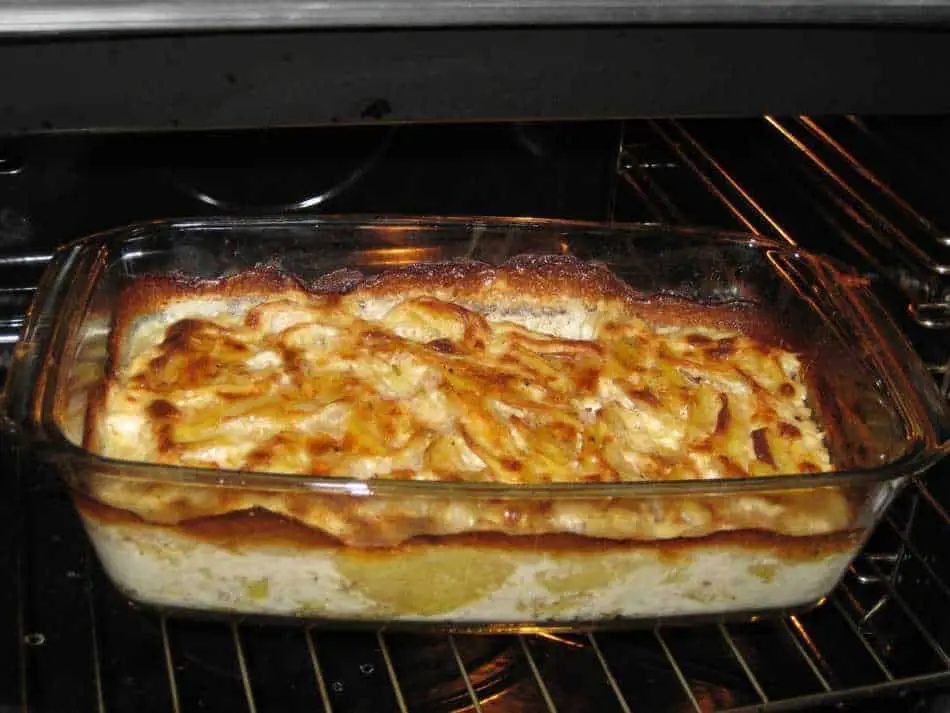You may have read the viral posts about Pyrex glass dishes exploding inside the oven, wondering if there’s some truth. Perhaps, you have Pyrex glass bakeware, and you worry that it may break or crack while in use.
So, can you put a cold Pyrex dish in the oven? You can put a cold Pyrex dish in the oven, provided you preheat the oven first to at most 428 degrees Fahrenheit. Thermal shock is possible which can damage the Pyrex dish if it has a frozen item on it that contains liquid.
Pyrex is clear about its glass products – they can withstand extreme temperatures. The range is from -4 to 572 degrees Fahrenheit for a measuring cup that is made from Pyrex. Pyrex.eu states that thermal shock that can damage Pyrex can happen at a temperature of 428 degrees.
Can A Glass Baking Dish Go from the Fridge to the Oven?
A glass baking dish can go from the fridge to the oven only if it is from tempered glass because it’s four times stronger than your average glass used in homes. Tempered glass is soda-lime glass that has been heat-treated to make it more durable.

According to AFG Industries fabrication development manager Mark Ford, tempered glass is four times better than annealed or ordinary glass. Moreover, if broken, it shatters into tiny but harmless pieces. Therefore, tempered glass is helpful in cases when human safety is a problem.
Glass undergoes a tempering process through heat treatment of at least six hundred degrees Celsius (1112 degrees Fahrenheit). Then, it goes through a quenching or high-pressure cooling procedure for a few seconds. Quenching cools the glass’s outer surfaces faster than the center, maintaining tension as the outside surfaces go through compression, thereby making the tempered glass stronger.
Tempered glass has 10,000 pounds per square inch surface compression and breaks at 24,000 pounds per square inch. On the other hand, the annealed glass breaks at 6,000 pounds per square inch.
Moreover, a glass dish made from tempered borosilicate glass is less prone to temperature changes and more robust because it has boric oxide that is highly resistant to sudden temperature changes, thermal shock, and chemical corrosion. Nowadays, many baking dishes, glass pie plates, and coffee carafes use tempered glass containing borosilicate.
If it’s your first time using a glass baking dish, you should check if it has the oven symbol at the bottom to ensure it’s safe. I recommend the Pyrex Square Baking Dish that is available on Amazon. Click here to have yours delivered to your front door.
Here is table that represents Pyrex that is presently popular for oven users:
| Type of Pyrex |
| 3 Quart Pyrex Baking Dish |
| 8 by 8-inch Casserole Dish |
| 2 Quart Rectangular Pyrex Baking Dish |
| 14 Piece Bakeware Pyrex (click here to buy) |
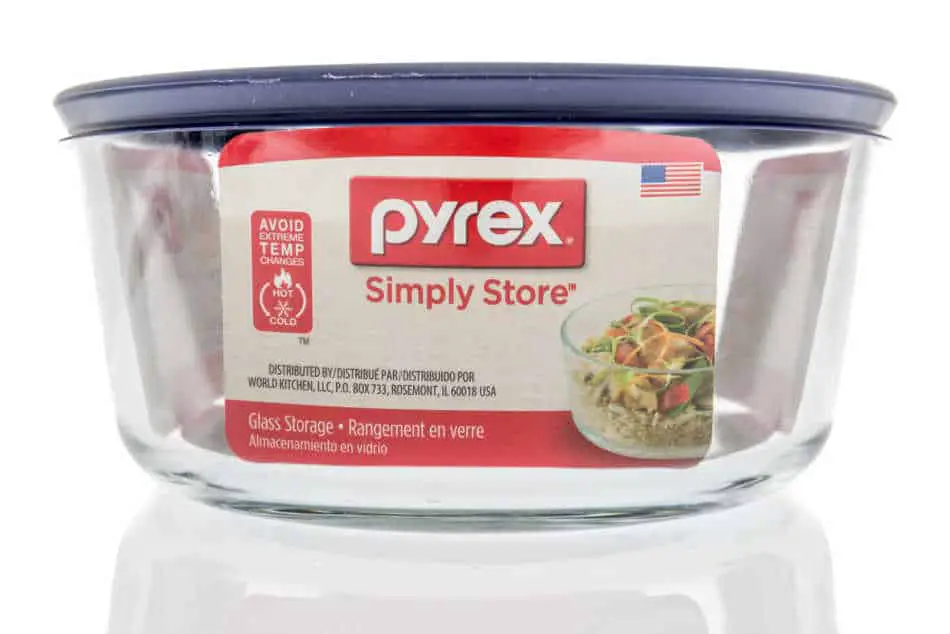
Can You Put a Cold Ceramic Dish in the Oven?
You cannot put a cold ceramic dish in the oven because it may explode in shards, divide in half, or create an invisible crack, weakening the container and failing over time. Thermal shock occurs because of sudden shifts in temperature, causing the ceramic volume to expand and causing the degradation of the material.

High temperatures make ceramics vulnerable to thermal shock fractures because of the rapid temperature change. Unlike metal, ceramic fiber can hold higher energy but prevents heat dissipation. All ceramics, including the oven-safe ones, can manage a specific heat level only.
The thermal shock changes the ceramic, causing the glaze to crack and making it challenging to clean. In addition, bacteria can build up in the cracks, making the dish unsafe to use. Moreover, dunting can cause the ceramic piece to lose its structural integrity and shatter into pieces, leaving an undesirable mess to clean up.
An oven-safe ceramic dish isn’t hard to find because it’s readily available in many supermarkets. However, it’s best to buy a medium-fired or high-fired bowl because it’s most resistant to changes in temperature.
However, a more robust ceramic material can better resist thermal shock, while a weak dish can quickly break under stress. A porous ceramic plate is more fragile and thus can crack easily. Condensation or water entering the ceramic dish pores can become steam and cause the piece to expand and crack upon heating. Solid ceramic is less porous. Extreme temperature changes can expand and shrink a ceramic dish significantly.
Here are some chemical and physical changes that occur to the ceramic body and glaze upon exposure to cooling and heating:
- Cracking can occur if there’s abrupt evaporation of moisture from the ceramic dish
- The ceramic piece can release oxidized organic material
- The glaze may soften, melt, flow, and trap gas during heating
- The ceramic plate can expand during heating and contract while cooling
- During cooling, the enamel can contract and solidify
If there’s silica in the glaze or ceramic body, it will quickly expand at 1063 degrees Fahrenheit and contract during cooling. In addition, rapid temperature changes can cause the dish to crack. Therefore, control of cooling and heating is critical to lessen the risk of thermal shock.
Best Bakeware – Is it Really Pyrex?
Here is a table that analyzes results from forum users on the best bakeware to use.
| Bakeware Type | Percentage of total results |
|---|---|
| Pyrex | 42% |
| Metal Pans | 17% |
| Copper Pans | 9% |
| Cast Iron | 25% |
| Aluminum | 7% |
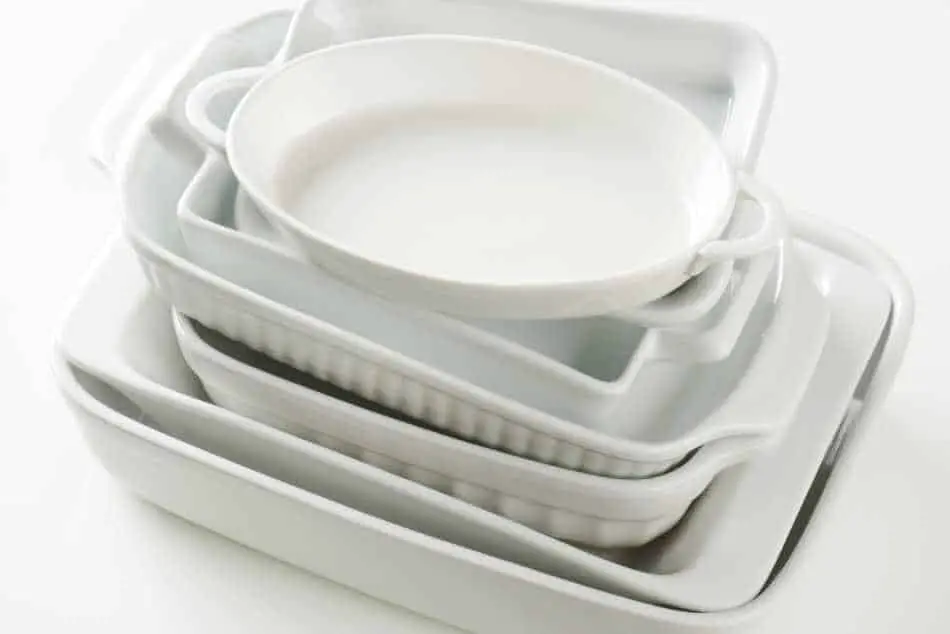
Can You Put a Frozen Glass Pyrex into a Hot Oven?
You cannot put a frozen glass Pyrex into a hot oven because thermal shock is possible due to abrupt temperature changes – from extremely cold to extremely hot. Glass expands and contracts due to thermal shock. Eventually, it will shatter.
It’s interesting to note that from 1908 to 1998, Corning manufactured Pyrex glassware with borosilicate glass, making it thermal shock resistant. However, the company sold the brand to World Kitchen LLC in 1998, and the new owner began using ordinary glass soda-lime glass.
Oven-safe Pyrex glass doesn’t mean that it’s thermal shock resistant. It can shatter when exposed to abrupt changes in temperature. Therefore, if consumers bought their Pyrex glassware from 1998 onward, they should handle it carefully because they have ordinary glassware.
It’s best not to put Pyrex glassware directly on the hot oven or stovetop from the freezer or refrigerator. Consequently, it’s not advisable to quickly move it to the fridge or freezer from the oven. Moreover, the Pyrex manufacturer advises consumers to preheat the oven before putting the glassware in it. Exposure of the glassware to the oven’s heating element can break or crack it.
In addition, a cold or hot Pyrex dish should be allowed to sit at room temperature before moving to the oven or refrigerator. Hot glassware should cool on a dry cloth, potholder, or cooling rack and not on a cool or wet surface. Moreover, it should be cool before refrigerating, washing, or freezing.
Even if you have the Pyrex borosilicate glass, you shouldn’t expose it to extreme temperatures because it will also crack. It would help if you didn’t quickly move your Pyrex glass dish from hot to cold temperatures. Moreover, it would be best not to place it on a stovetop.
It will help if you preheat your oven before placing your Pyrex glass dish to avoid exposing it to considerable temperature changes. Moreover, you should ensure that the container is at room temperature before putting it in the refrigerator, freezer, or oven.
Why Does My Glass Cooking Dish Say Preheated Oven Only?
Your glass cooking dish says preheated oven only because it will potentially break if you don’t do so. The oven’s heating element produces radiant heat that is too intense for the glass dish when it attempts to reach the desired temperature. Exposure to this high level of radiant heat can damage the glass.
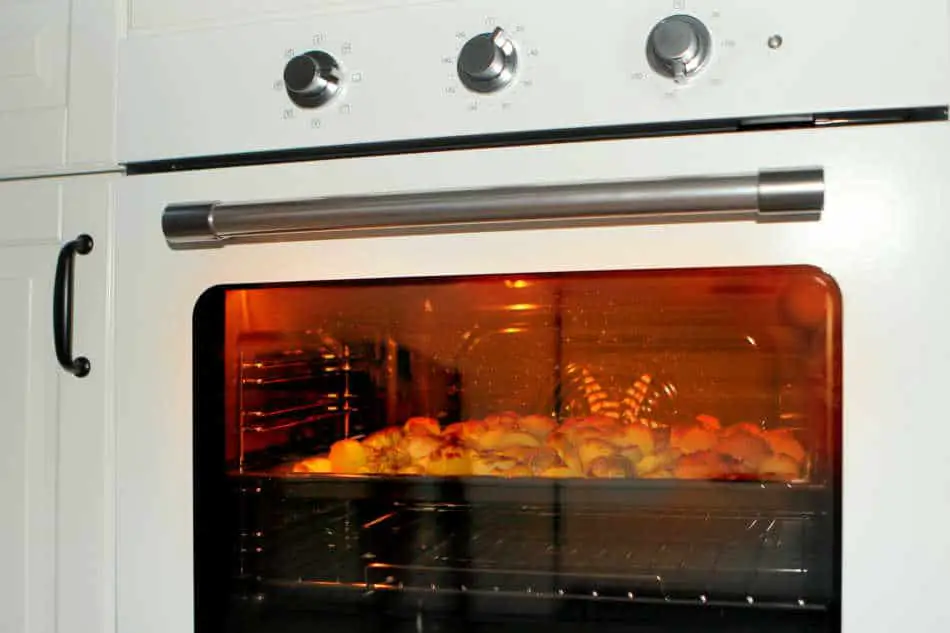
Preheating the oven at the desired temperature of 320 to 360 degrees Fahrenheit takes on average ten minutes. However, preheating takes five minutes more if the recipe requires a higher temperature of 400 degrees Fahreneheit.
Glass is a poor heat conductor; therefore, heat doesn’t travel faster through the material. As a result, the area exposed directly to the heat becomes hot; however, the rest of the glass dish is at a lower temperature. Glass breaks because of uneven heating.
Moreover, heated glass expands because the heat energy fills the molecules, making them move around. On the other hand, as it cools, the molecules contract. The heated glass part expands quickly during the rest of the glass contracts because glass is a poor heat conductor.
Glass can potentially break because of the opposing forces of expansion and contraction. If the temperature difference is higher, the opposing forces are more vital; thus, the higher probability of glass breakage due to thermal shock.
Therefore, ensure that the dish is oven-safe to minimize the possibility of glass breaking. Most glass dishes have the “oven-safe” symbol, which may vary depending on the manufacturer because there’s no standard symbol yet.
Moreover, glass dishes shouldn’t be in an oven at high temperatures to prevent thermal shock. Glass melts at 1,300 degrees Fahrenheit. Still, baking temperatures are often from 300 degrees Celsius to 450 degrees Fahrenheit, much lower than the melting point of glass. However, glass dishes may still crack inside the oven due to uneven heating.
Can You Put Cold Pyrex in the Microwave?
You can put cold Pyrex in the microwave oven because it’s microwave-oven and freezer safe. Pyrex glass is also thermal-shock resistant at 428 degrees Fahrenheit, meaning if you freeze it at -4 degrees Fahrenheit, you can put it directly in an oven at 400 degrees Fahrenheit.
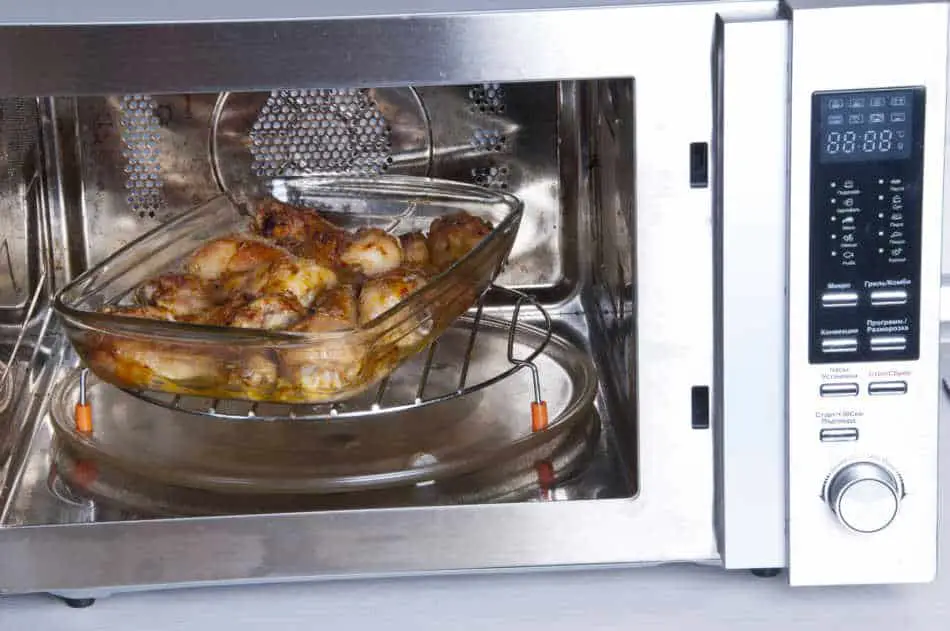
Microwave ovens convert electricity into microwaves to heat food through a high-voltage capacitor. The waves heat the water molecules in liquids and food items to reheat, defrost, or cook meals. However, the oven transfers the heat to food; therefore, the range doesn’t get hot.
Moreover, the food’s water content is the primary factor in cooking through the microwave oven. The oven’s component may fail because of electrical issues like the overloading of circuits.
Liquids or food heated in a microwave oven don’t get hotter than 212 degrees Fahrenheit or 100 degrees Celsius (water’s boiling point). However, solid foods heated at a higher temperature will become tough and dry because of the evaporation of their water content. Some microwave oven models can prevent the superheating of liquids through a safety feature.
Therefore, thermal shock can only occur if the cooking temperature breaches the Pyrex glass dishes’ 220 degrees Celsius thermal resistance or the microwave oven heats the food beyond 100 degrees Celsius. However, if the glass has chips or notches from use, the dish can break or explode.
To prevent glass breakage, it’s also advisable to stir the contents to ensure even heat distribution and heating of the food. Glass won’t melt inside the microwave oven. Still, to ensure it won’t break or crack, it should be in the microwave oven for less than five minutes.
Why Did My Pyrex Dish Explode In The Oven?
Your Pyrex dish exploded in the oven because of inappropriate use. You might not have noticed that it already had chips or cracks when you placed it in the oven; thus, the temperature change affected the structural integrity resulting in the explosion of the glass dish.

Michael Sullivan of the New York Times explained the issue at length. He said it’s the nature of glass to be unpredictable and brittle. However, tempering attempts to limit this disadvantage, but the process isn’t perfect. Tempered glass has stored energy in its center balanced by the exterior’s surface compression and held in tension. Therefore, a crack can disrupt the balance, causing the Pyrex glass to explode.
If users unintentionally drop a tempered glass, the impact breaks the tension. However, they may not notice the tiny crack. Therefore, if they subject it to extreme temperatures, they may be surprised that it explodes into cube-like pieces.
Tempered glass can shatter due to several factors, but the most common reasons are manufacturing flaws, extreme thermal stress, surface damage, stress relaxation, or its combination. Rough treatment of glass, such as banging it with another item, dropping it, or scratching it, can cause surface damage.
Thermal stress can result from exposing the Pyrex glass to extreme temperature causing the glass to expand in one area and contract in another. Moreover, the complexity of the shape of the tempered glass bakeware makes it challenging to temper uniformly. Therefore, imperfections can arise with improver tempering resulting in a structural flaw.
Lastly, the temper in the glass can deteriorate over time, causing stress relaxation. Users may repeatedly use it at high temperatures; thus, a spontaneous fracture can occur. However, everyday household use shouldn’t cause stress relaxation. Users should follow Pyrex’s instructions in using their glass dish. They should avoid using it on the stovetop, in a toaster oven, under the broiler, or on a barbecue grill to avoid stress relaxation.

